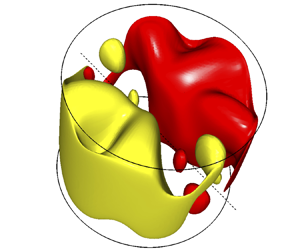Article contents
On the origins of steady streaming in precessing fluids
Published online by Cambridge University Press: 21 January 2021
Abstract

The finite-amplitude space–time mean flows that are precessionally forced in rotating finite circular cylinders are examined. The findings show that, in addition to conventional Reynolds-stress-type source terms for streaming in oscillatory forced flows, a set of Coriolis-type source terms due the background rotation also contribute. These terms result from the interaction between the equatorial component of the total rotation vector and the overturning flow that is forced by the precession, both of which have azimuthal wavenumbers  $m={\pm }1$. The interaction is particular to precessing flows and does not exist in rotating flows driven by libration (
$m={\pm }1$. The interaction is particular to precessing flows and does not exist in rotating flows driven by libration ( $m=0$ forcing) or tides (
$m=0$ forcing) or tides ( $m={\pm }2$ forcing). By examining typical example flows in the quasi-linear weakly forced streaming regime, we are able to consider the contributions from the Reynolds-stress terms and the equatorial-Coriolis terms separately, and find that they are of similar magnitude. In the cases examined, the azimuthal component of streaming flow driven by the equatorial-Coriolis terms is everywhere retrograde, whereas that driven by Reynolds stresses may have both retrograde and prograde regions, but the total streaming flows are everywhere retrograde. Even when the forcing frequency is larger than twice the background rotation rate, we find that there is a streaming flow driven by both the Reynolds-stress and the equatorial-Coriolis terms. For cases forced at precession frequencies in near resonance with the eigenfrequencies of the intrinsic inertial modes of the linear inviscid unforced rotating cylinder flow, we quantify theoretically how the amplitude of streaming flow scales with respect to variations in Reynolds number, cylinder tilt angle and aspect ratio, and compare these with numerical simulations.
$m={\pm }2$ forcing). By examining typical example flows in the quasi-linear weakly forced streaming regime, we are able to consider the contributions from the Reynolds-stress terms and the equatorial-Coriolis terms separately, and find that they are of similar magnitude. In the cases examined, the azimuthal component of streaming flow driven by the equatorial-Coriolis terms is everywhere retrograde, whereas that driven by Reynolds stresses may have both retrograde and prograde regions, but the total streaming flows are everywhere retrograde. Even when the forcing frequency is larger than twice the background rotation rate, we find that there is a streaming flow driven by both the Reynolds-stress and the equatorial-Coriolis terms. For cases forced at precession frequencies in near resonance with the eigenfrequencies of the intrinsic inertial modes of the linear inviscid unforced rotating cylinder flow, we quantify theoretically how the amplitude of streaming flow scales with respect to variations in Reynolds number, cylinder tilt angle and aspect ratio, and compare these with numerical simulations.
- Type
- JFM Papers
- Information
- Copyright
- © The Author(s), 2021. Published by Cambridge University Press
References
REFERENCES
- 8
- Cited by



